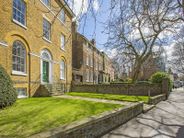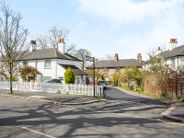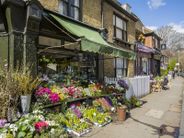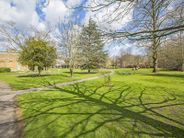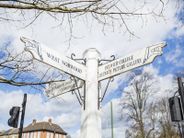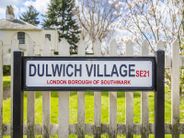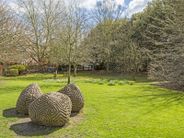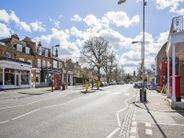
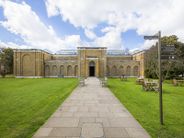
Dulwich Village
Average sold price last 12 months
£2,307,298
What's it all about?
Mansion houses, millponds, a golf course and horse riding trails… in Dulwich Village you’d be forgiven for thinking you’d stumbled on a rural idyll, albeit one in Zone 3 and 17 minutes to London Bridge. It is one of the few inner London areas that has managed to maintain a ‘true’ village charm, Combined, these earned Dulwich Village its conservation area status in 1968. This exclusive and upmarket area has a charming, old world atmosphere with mature chestnut trees, leafy streets, white picket fences and a great range of independent shops, boutiques and cafes, as well as a Grade II listed pub. The area’s expansive and attractive green spaces are its biggest draw, from Dulwich Park, where highwaymen once terrorised local nobility, to Dulwich Wood, where the court of Charles I met to hunt deer. Famous for its art gallery and open spaces, Dulwich Village is a magnet for higher income families because of the exclusive family homes, transport links into the City and central London and its world class schools.
Fact file
- Dulwich Village was first recorded in AD967 as Dilwihs, meaning ‘dill meadow’.
- Rembrandt’s portrait of Jacob De Gheyn III has been stolen from the Dulwich Picture Gallery four times since 1966. It was found every time, once each in a taxi, a train station, underneath a bench and on the back of a bicycle.
- London’s last remaining tollgate is located on College Road. Constructed in 1789, today the standard toll for non pass holders is £1.20 per single journey.
Architecture and property
Dulwich Village has a diverse range of large Victorian, Edwardian, as well as Arts & Crafts, award-winning 50s architecture, 30s, and 20s properties. The area has a unique London English country village feel, complete with duck pond and Grade-II-listed pubs such as The Crown and Greyhound, known to locals as The Dog. West Dulwich is home to larger Victorian properties, especially on the streets near Dulwich College, while East Dulwich’s Victorian terraces tend to be more compact. Many properties have since undergone loft conversions to accommodate growing families.
Steeped in history, the architecture of Dulwich Village is period and traditional, with a variety of Georgian architecture surrounded by Victorian and Edwardian properties that came with the railways in the 1870s. A few delightful ‘rose cottages’ can be found discreetly tucked away in the heart of the neighbourhood, as can a number of idyllic 1920s/1930s houses with their abundance of light and space. Many properties have been renovated and extended to create contemporary homes. Today, Dulwich Village remains a private estate owned by the Dulwich Estate, a charity that, historically, has managed the neighbourhood and presently controls local development. There are some very large five, six and seven bedroom houses in the area, and others that have been converted into spacious two and three bedroom flats.
For house price information please visit the sold data tab.
Going out
Eating: Recently renovated and family friendly, Rocca boasts an outdoor terrace and wood fired ovens for its authentic Italian fare. Nothing beats the simple delights from Gail’s Bakery. For spectacular dining in a Georgian manor house, head for Belair House, specialising in British cuisine. Pizza Express is always popular with the locals.
Culture: Dulwich Picture Gallery is the world’s first purpose built public art gallery. Designed by Sir John Soane, it houses a world class collection of Old Masters as well as a rather fine cafe. The nearby Horniman Museum on London Road offers another cultural fix – its glass cases of anthropological and natural history curiosities will fascinate the kids and adults alike.
Relaxation: Dulwich Village has a beautician, Lesley Leale-Green, and something for the gentlemen at Porters Barbers, a traditional style barber shop that also offers facials and waxing.
Events: The Dulwich Festival is an annual event taking place over a week in May and celebrates the talent of the area’s residents. There are exhibitions of art, an artists’ open house event, walks, talks and music recitals. The festival ends with the Dulwich Village fun day and, which has been known to finish with a pram race or a dog show.
Local amenities
- Dulwich Village is also the name of the high street and here locals come together to enjoy the boutiques, cafes, deli food shops and a wide range of independent services including a dry cleaner, an optician, an artists’ supply shop (with a toyshop at the back) and a soft furnishings store. Book lovers make for Dulwich’s oldest bookshop, Village Books, while artists, both budding and experienced, should check out The Art Stationers. For those in search of a gift, Jane Newbery offers a refreshingly eclectic and humorous mix of home accessories, gifts, and artworks.
- Romeo Jones is a truly local deli, where you can buy honey produced by Dulwich bees alongside locally made chocolates, bread, and preserves. You can also enjoy a coffee or a snack and there is even an art gallery to view at your leisure.
- For the larger grocery shop, there is a Sainsbury’s and Marks & Spencer in nearby East Dulwich and an Asda in Peckham.
- Dulwich Library was donated to the community by Dulwich College and today serves thousands of visitors each month.
- For fitness enthusiasts, the Dulwich College Sports Club offers a wide range of facilities, including swimming, badminton and tennis, and Dulwich and Sydenham Golf Course boasts panoramic views across the Capital to enjoy.
Green spaces
Dulwich Park is a 72 acre stretch of green meadow in the heart of the village. Refurbished in 2006, the park has a boating lake, visitor centre, tennis courts and a bowling green. You can also hire tandem bicycles for a gentle exploration for two, while the more competitively minded cyclist will head for the historic Herne Hill Velodrome. Nearby Brockwell Park has a walled flower garden, charming 19th century clock tower and a popular lido, and is home to the Lambeth Country Show each July, which is a mix of country fair, live music and funfair.
Changing times
The Dulwich Estate has developed 1500 acres around Dulwich to provide an array of properties in a range of architectural styles to suit any resident. Historic Dulwich Village pub Crown & Greyhound has been refurbished with the addition of a boutique hotel.
Transport
Rail: North Dulwich is the closest station to Dulwich Village, located on the border of Zones 2 and 3 and only about a three minute walk from the village centre. North Dulwich to London Bridge takes 17 minutes and trains run frequently. West Dulwich station is slightly further away, and offers four trains an hour to Victoria.
Road: The South Circular is a four minute drive away, and it’s possible to be on the M25 in under an hour.
Bus: Buses 37, P4 and P13 all serve Dulwich Village, travelling to New Cross, Peckham, Lewisham, East Dulwich, Streatham, Herne Hill, Putney and Brixton. The 42 also serves Dulwich Village, travelling to East Dulwich, Camberwell, Old Kent Road, Tower Bridge and Liverpool Street.
Getting away: Gatwick Airport is less than an hour’s drive away.
Education
Dulwich's schools attract pupils from all over London, both boarders and day pupils. Dulwich has two state primary schools, Dulwich Hamlet Junior School and Dulwich Village Infants School, a well-regarded academy in Kingsdale Foundation School, as well as three of London’s top independent schools: James Allen's Girls' School, Dulwich College and Alleyn’s.
Please see our schools tab for more information on schools in this area.
If you’re looking to buy, sell, rent or let in Dulwich Village, contact the KFH Dulwich Village branch today.
Find a property
Looking for a property valuation?
Get an accurate, no-obligation valuation from our local experts.
